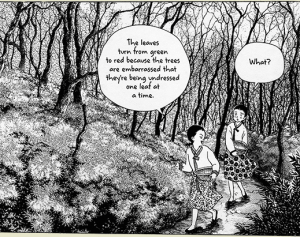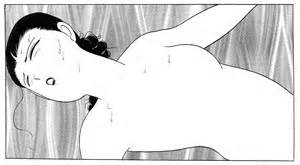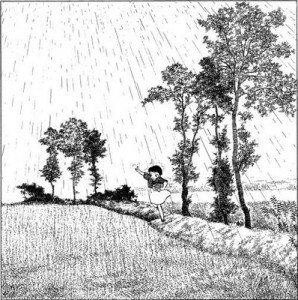Welcome to Using Graphic Novels in Education, an ongoing feature from CBLDF that is designed to allay confusion around the content of graphic novels and to help parents and teachers raise readers. In this column, we examine graphic novels, including those that have been targeted by censors, and provide teaching and discussion suggestions for the use of such books in classrooms.
In 2011, an acclaimed Korean manwha (comic) series was second on ALA’s list of most frequently challenged books list. This post takes a closer look at that series, The Color of Earth trilogy, by Kim Dong Hwa — The Color of Earth, The Color of Water, and The Color of Heaven — examining its merits, issues of concern, and teaching elements to empower educators and parents to make their own decisions.
OVERVIEW
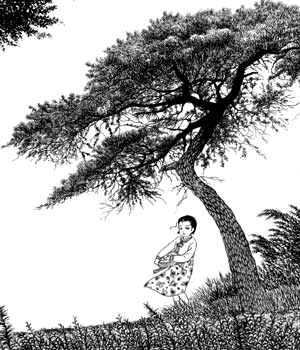 Kim Dong Hwa is a widely popular Korean comic artist. In the Color Trilogy, Dong Hwa tenderly tells the story of his mother’s growth into womanhood, as he imagined it might have been. This story is an incredible blend of prose, poetry, and penciled art. It is a story about young Ehwa’s growing curiosity about sex, puberty, and relationships. Based on Ehwa’s observations and interactions with friends, nature, and the villagers around her, she has wonderfully frank discussions with her mother, who tactfully and sensitively opens the world up for Ehwa.
Kim Dong Hwa is a widely popular Korean comic artist. In the Color Trilogy, Dong Hwa tenderly tells the story of his mother’s growth into womanhood, as he imagined it might have been. This story is an incredible blend of prose, poetry, and penciled art. It is a story about young Ehwa’s growing curiosity about sex, puberty, and relationships. Based on Ehwa’s observations and interactions with friends, nature, and the villagers around her, she has wonderfully frank discussions with her mother, who tactfully and sensitively opens the world up for Ehwa.
The Color Trilogy has met with both outstanding praise for its beautiful, creative, and sensitive content and with strong criticism, resistance, and banning over content, nudity, and discussions of sexuality.
Merits
While there is some nudity and sexual content in this narrative, most of Ehwa’s explorations are done through her observations of the world around her and through intimate discussions with her mother. Kim Dong Hwa’s prose, poetry, and glorious lush art allow us to watch and learn along with Ehwa. Though the art is black and white, the wide range of textures and details add incredible depth and complexity to the story. It is truly a feast for mind and eyes.
Flowers, butterflies, insects, water, the position of slippers laid out, and the seasons of the year course steadily through the story, serving as mentors and metaphors for young Ehwa as she learns about love and life around her. And while this story is the story of the author’s mother, set in a “timeless village” in rural Korea, it can speak to young adults of all ages and cultures, while teaching about traditional Korean culture. Even today, the story will resonate with women of all ages who are sorting out what it means to be female within the world of men.
Elements of Concern
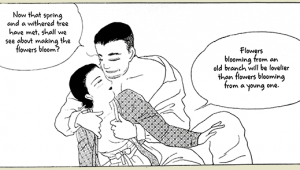 The Color of Earth trilogy, however, has a sad history of being challenged and banned, primarily for its nudity and sexual content. In 2011, the American Library Association ranked The Color of Earth as the second most challenged book of the year.
The Color of Earth trilogy, however, has a sad history of being challenged and banned, primarily for its nudity and sexual content. In 2011, the American Library Association ranked The Color of Earth as the second most challenged book of the year.
What is so unfortunate is that this is such a warmly sensitive story that delicately answers so many questions young teenage girls might have about their budding sexuality. Furthermore, much of the discussion of sexuality is couched in metaphor and explored through nature (such as the timing of various flower blossoms and the coupling of beetles). This makes it difficult to pigeonhole in which grades it might be taught. That said, it is recommended for grades 10+. Given the nature of this series and its content, it is an outstanding book for book clubs and begs discussion as well as quiet contemplation.
SUMMARY
BOOK ONE: THE COLOR OF EARTH spans Ehwa’s life from age seven to sixteen. We watch Ehwa as she grows up, helping her widowed mother run the local tavern in their rural Korean village of Namwon. The theme in this first volume is all about Ehwa’s relationship with her mother and their mutual sexual awakenings. As Ehwa, enters puberty, her mother enter a new relationship with The Picture Man.
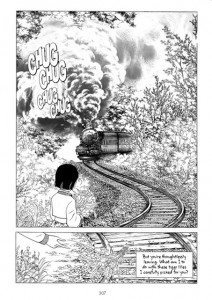 Each chapter in the book chronicles a spring in Ehwa’s life. Observing the banter, gossip, and innuendos of her mother’s customers, exploring her budding body and her relationship with her friends, learning from the trees, insects, and flowers around her, and watching as her mother falls in love with an itinerant painter, we look on as Ehwa explores her sexual awakening and begins to learn about love.
Each chapter in the book chronicles a spring in Ehwa’s life. Observing the banter, gossip, and innuendos of her mother’s customers, exploring her budding body and her relationship with her friends, learning from the trees, insects, and flowers around her, and watching as her mother falls in love with an itinerant painter, we look on as Ehwa explores her sexual awakening and begins to learn about love.
In this first volume, Ehwa discovers the physical differences between boys and girls, gets her first period, and bumbles through naturally confusing experiences with attraction and romance. Her first encounter is with a young Buddhist monk — a relationship doomed to failure because of his faith’s strict celibacy code. At the same time, her mother meets The Picture Man. Ehwa learns from them about the sorrows and joys of a romantic relationship. Later in this first volume, Ehwa has a brief encounter with a second young man, Sunoo, a young student who is temporarily home due to an injury. This second relationship is also bound for failure as the young Sunoo is from a wealthy family and girls like Ehwa would never be considered as potential love interests.
BOOK TWO: THE COLOR OF WATER follows Ehwa’s later development and exploration of relationships. While preparing for a town festival, Ehwa meets Duksam, a strong young man whom she later sees at the festival’s wrestling championship. After he wins the prize bull and after some initially unwanted attention, he and Ehwa secretly begin to meet. But a shadow falls over their budding romance as Master Cho, 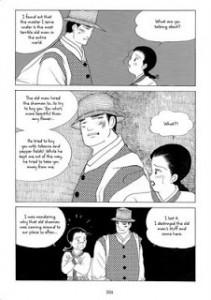 Duksam’s master, tries courting Ehwa himself. Mother and daughter continue to grow closer and more intimately and maturely discuss each one’s growing love for the too-often-missing men in their lives.
Duksam’s master, tries courting Ehwa himself. Mother and daughter continue to grow closer and more intimately and maturely discuss each one’s growing love for the too-often-missing men in their lives.
Like Book One, this installment will appeal to mature readers as Book Two continues the story of Ehwa’s sexual awakening. In The Color of Water Ehwa experiences love’s first kiss, and sensitively discovers masturbation.
BOOK THREE: THE COLOR OF HEAVEN begins as Duksam has fled the village and Ehwa finds her relationship with love much like her mothers. Both women lament the stresses of waiting for their men and comfort each other in their loneliness. In this wonderfully sensitive third and final volume, Ehwa grows into a woman, she more fully understands and experiences love, and her mother continues as her constant model and confidante. With the first snow of her eighteenth year, Ehwa’s true love comes at last. With her mother’s blessing Ehwa marries and experiences the bliss of the bridal night. The art of this final act is exquisite, erotic, and sensitive.
NOTE: There is a Reading Group Guide for the trilogy at the end of The Color of Heaven as well as Discussion Questions.
DISCUSSION SUGGESTIONS
Plot, Theme, and Character Development
- Kim Dong Hwa provides a great deal of detail as he discusses his mother and grandmother’s lives growing up in late nineteenth century Korea. Search for details of daily life, annual festivals, and customs. Have students create a travel brochure for Namwon village, making sure to describe its life and festivals as they discuss what there is to see and do there.
- Compare the roles of men and women in The Color Trilogy. How are they similar/different from Western roles when comparing the roles of nineteenth century Korea versus the West as well as male/female roles in the present?
- Plot and evaluate Ehwa’s relationship with her mother over the course of the story/books. Discuss how it changes and how empowering it was for each of them. You may also want to discuss how Ehwa’s relationship with her mother changes in the presence of The Painter Man.
- Evaluate and discuss how Ehwa and Bongsoon are portrayed — their rivalries, their similarities, and their differences. Why are they portrayed in this way?
- Throughout the trilogy, Ehwa’s mother presents her with different ways of coping. Discuss these different ways and how things do and do not change over time.
- One example can be found o page 36 of The Color of Heaven, when Ehwa’s mother tells her, “A wound on your skin can be easily healed with ointments, but a wound of the heart needs a good cry to start healing itself.”
- On page 48-50, her mother tells her, “If you’re all done seeping, put the leaves in the stove and burn them. With each leaf you add to the stove, include a bit of your pain as well…. When you do that, you’ll see that your heart becomes a little lighter.”
Critical Reading and Making Inferences
- Discuss Dong Hwa’s use of nature as metaphor for Ehwa’s budding sexuality. For example: Search for examples and discuss his use of flowers to describe women, discuss his use of wind to describe men, and his use of the women planting gourds to portray love and longing (see page 75 in The Color of Earth for a lovely use of prose, too).
- Discuss how social mores have changed over time. For example, on page 228 in The Color of Water, Ehwa’s mother tells her, “You’re not a child anymore. You’re at an age where you should be mindful of your heart and body and conduct yourself with dignity.” Discuss her mother’s implications and how things have and have not changed across time and/or culture.
- Discuss how Ehwa’s mother disciplines and teaches her. Have students compare and contrast how Ehwa was disciplined to how they are disciplined by their parents. (One great example of Ehwa’s mother disciplining her can be found on pages 34-35 in The Color of Heaven.)
- Discuss the role the village market plays in this story. What do we have today that is comparable to the market?
- Examples of inference to discuss:

- The Color of Earth, page 82: “It’s a strange thing. Why does it (the gourd) bloom and open its lovely white petals only at night, when there’s nobody around to admire it.”
- The Color of Earth, page 228: “Even though a son might stay with me until I die, I would never be able to tell him all the things I tell you. I would never be able to reveal my vulnerability to a son.”
- The Color of Water, page 12: “These flowers behave like women.” “Flowers have been blooming all around us since March, so why the sudden interest in them?”
- The Color of Water, page 52:“But still, my dear daughter, while the passion of the eyes may be like lightening, the passion of the heart is like a hearth. And hearth is the light that remains lit all throughout the night.”
- The Color of Water, page 184 Discuss the implications of Ehwa’s statement, “It sounds like the heartache of Chungja’s marriage will be longer than any railroad.”
- The Color of Water, page 218: “When a flower is inside the fence, can a butterfly outside resist the temptation to come in?”
- The Color of Heaven, page 141: “What’s the point of dressing a street peddler in silk clothes? On him, they’ll look like a piece of rope hanging from a pole. Yet even if you clothe hi with tattered rags, as long as there’s feeling and warmth in your actions, then e will gain strength and look alive.”
- The Color of Heaven, page 146: “If a woman has too much time on her hands, she begins to think of crazy and useless things.”
- The Color of Heaven, page 233: “A monk needs to meander down paths a bit so he can relate to the masses and their meandering ways.”
Language, Literature and Language Usage
- Search, find, and discuss Dong Hwa’s use of metaphor throughout these books.
- Analyze and discuss the poem that opens each of the three books, making sure to discuss its intent and significance.
- The Color trilogy is full of metaphor, simile, and foreshadowing. Search for and analyze various incidents of each.
- Throughout the trilogy, there are examples of Dong Hwa’s use of prose and inference. Analyze his choice of words when creating his metaphors and inferences.
- Discuss Dong Hwa’s blend of prose and poetry. For example:
- The Color of Earth, page 75, he writes: “In one gourd; Longing vaster than the heavens; In one gourd; Waiting longer than night; On top of the gate; On top of the roof; A lantern is lit. A woman dressed and ready eagerly awaits her love.”
Cultural Diversity, Civic Responsibilities, and Social Issues
- While this is really Ehwa’s story, we get a glimpse into the differences in male and female roles in her Korean village, a well as a glimpse into class differences, particularly when we meet Sunoo, the wealthy boy home from school. Piece together and discuss the social issues faced by Ehwa and her mother.
- Discuss the “standards” and values Ehwa had to follow. How are they similar/different to values and standards today?
- Research and discuss the various festivals mentioned throughout the trilogy.
- Describe what it was like in Namwon for Ehwa and her widowed mother. Discuss issues they faced with no man present. Compare to contemporary culture. How have things changed? How is it similar and different today?
- Identify traditional Korean festivals, beliefs ,and cultural mores. How do they compare to our own? Discuss the Korean versus the Western way of life. Have students research and discuss modern versus traditional Korean cultural experiences.
Modes of Storytelling and Visual Literacy
- Compare and contrast Kim Dong Hwa’s use of visual and verbal metaphor and foreshadowing.
- Dong Hwa uses a lot of visual symbolism to tell his mother’s story. Chart, evaluate, and discuss his use of shoes, flowers, and insects, and analyze what they represent. Is this representation consistent? Why or why not?
- While the art in this series is in black and white, it has a rich, engaging feel to it. Discuss Kim Dong Hwa’s use of texture and detail.
- Chart and compare the textured images versus the simpler ones. Is there a pattern to their use? Discuss how he changes the textures and details not only to emphasize particular points, but also to keep the reader engaged.
Paired Reading Suggestions
- A Tree Grows in Brooklyn by Betty Smith is a coming-of-age story about an impoverished but aspirational third-generation American teen and her ethnically blended family living in Williamsburg, Brooklyn, during the early 20th century.
- So Far From the Bamboo Grove and My Brother, My Sister, and I by Yoko Kawashima Watkins is a two-volume autobiographical story that begins with her last days as a Japanese girl living with her family in Nanam in northern Korea and the family’s escape towards the end of World War II (as Japanese living near the Chinese border at the end of the war were suddenly in terrible danger). Yoko tells about the hardships of fleeing Korea towards the end of the war, how she had to conceal being female to avoid being raped, and how eventually her family, separated by unfortunate circumstances ends in the United States. This is a coming-of-age story about courage and survival.
- His Dark Materials Trilogy (The Golden Compass; The Subtle Knife; The Amber Spyglass) by Phillip Pulman is a coming-of-age science fiction fantasy of alternate worlds all centered in Oxford, England, that weaves philosophy, religion, history, science, literature, and coming of age into a breath-taking life-adventure story. Lyra, a young teen is the lynchpin and heroine who must master and battle elements of multiple worlds to save herself and all those around her.
- Be Confident in Who You Are by Annie Fox is a graphic novel that offers advice on common middle school concerns and practical advice for being healthy and for staying in control of your feelings and actions.
- SideScrollers by Matthew Loux is about contemporary teen life, addressing issues of cliques, social pressures, and developing sexuality. The characters are true to life, yet there is no real hero archetype.
Common Core State Standards Common Core State Standards (CCSS)
As the content of these books is recommended for mature teens, grades 10+, its classroom use becomes more challenging. As noted in the introduction, however, there are no doubt, classrooms that will be well-served with the content, language and structure of this story, as well as the beautiful glimpse into Korean late nineteenth-century culture. In discussing how this book meets CCSS, I will be using the Common Core Anchor Standards for College and Career Readiness for Reading, Writing, and Speaking and Listening to help guide interested educators.:
- Knowledge of Language: Apply knowledge of language to understand how language functions in different contexts, to make effective choices for meaning or style, to comprehend more fully when reading or listening.
- Vocabulary Acquisition and Use: Determine or clarify the meaning of unknown and multiple-meaning words and phrases by using context clues, analyzing meaningful word parts, and consulting general and specialized reference materials; demonstrate understanding of figurative language, word relationships, and nuances in word meaning; acquire and use accurately a range of general academic and domain-specific words and phrases sufficient for reading, writing, speaking and listening at the college and career readiness level.
- Key ideas and details: Reading closely to determine what the texts says explicitly and making logical inferences from it; citing specific textual evidence when writing or speaking to support conclusions drawn from the text; determining central ideas or themes and analyzing their development; summarizing the key supporting details and ideas; analyzing how and why individuals, events, or ideas develop and interact over the course of the text.
- Craft and structure: Interpreting words and phrases as they are used in a text, including determining technical, connotative, and figurative meanings and analyzing how specific word choices shape meaning or tone; analyzing the structure of texts, including how specific sentences, paragraphs and larger portions of the text relate to each other and the whole; Assessing how point of view or purpose shapes the content and style of a text.
- Integration of knowledge and ideas: Integrate and evaluate content presented in diverse media and formats, including visually…as well as in words; delineate and evaluate the argument and specific claims in a text, including the validity of the reasoning as well as the relevance and sufficiency of the evidence; analyze how two or more texts address similar themes or topics in order to build knowledge or to compare the approaches the authors take
- Range of reading and level of text complexity: Read and comprehend complex literary and informational texts independently and proficiently
- Research to Build and Present Knowledge: Conduct short as well as more sustained research projects based of focused questions, demonstrating understanding of the subject under investigation; gather relevant information from multiple print and digital sources, assess the credibility and accuracy of teach source, and integrate the information while avoiding plagiarism; draw evidence from literary or informational texts to support analysis, reflection, and research.
- Comprehension and collaboration: Prepare for and participate effectively in a range of conversations and collaborations with diverse partners, building on others’ ideas and expressing their own clearly and persuasively; integrate and evaluate information presented in diverse media and formats, including visually, quantitatively and orally; evaluate a speaker’s point of view, reasoning, and use of evidence and rhetoric.
- Presentation of knowledge and ideas: Present information, findings, and supporting evidence such that listeners can follow the line of reasoning and the organization; adapt speech to a variety of contexts and communicative tasks, demonstrating command of formal English when indicated or appropriate.
This book and related discussions also cover the following themes identified by The National Council for the Social Studies:
- Time, Continuity, and Change — “…facilitate the understanding and appreciation of differences in historical perspectives and the recognition that interpretations are influenced by individual experiences, societal values, and cultural traditions… examine the relationship of the past to the present and extrapolating into the future… provide learners with opportunities to investigate, interpret, and analyze multiple historical and contemporary viewpoints within and across cultures related to important events, recurring dilemmas, and persistent issues, while employing empathy, skepticism, and critical judgment…”
- Individual Development and Identity — “…describe how family, religion, gender, ethnicity, nationality, socioeconomic status, and other group and cultural influences contribute to the development of a sense of self…have learners compare and evaluate the impact of stereotyping, conformity, acts of altruism, discrimination, and other behaviors on individuals and groups…”
- Individuals, Groups, and Institutions — “…help learners understand the concepts of role, status, and social class and use them in describing the connections and interactions of individuals, groups, and institutions in society…analyze groups and evaluate the influence of institutions, people, events, and cultures in both historical and contemporary settings…identify and analyze examples of tensions between expressions of individuality and efforts of groups and institutions to promote social conformity…”
Links and Resources:
- Preview of The Color of Earth http://us.macmillan.com/thecolorofearth/DongHwaKim
- Preview of The Color of Water http://us.macmillan.com/thecolorofwater/DongHwaKim
- Preview of The Color of Heaven http://us.macmillan.com/thecolorofheaven/DongHwaKim
- For details on book banning and censorship: “History of Comics Censorship, Part 6”.
- For a list of banned and censored comics, please see “Banned Books Week: Challenged and Banned Comics”.
- Travel video of Namwon: https://www.youtube.com/watch?v=0zu3sHnfW3U
Meryl Jaffe, PhD teaches visual literacy and critical reading at Johns Hopkins University Center for Talented Youth Online Division and is the author of Raising a Reader! and Using Content-Area Graphic Texts for Learning. She used to encourage the “classics” to the exclusion comics, but with her kids’ intervention, Meryl has become an avid graphic novel fan. She now incorporates them in her work, believing that the educational process must reflect the imagination and intellectual flexibility it hopes to nurture. In this monthly feature, Meryl and CBLDF hope to empower educators and encourage an ongoing dialogue promoting kids’ right to read while utilizing the rich educational opportunities graphic novels have to offer. Please continue the dialogue with your own comments, teaching, reading, or discussion ideas at meryl.jaffe@cbldf.org and please visit Dr. Jaffe at http://www.departingthe text.blogspot.com.
We need your help to keep fighting for the right to read! Help support CBLDF’s important First Amendment work by visiting the Rewards Zone, making a donation, or becoming a member of CBLDF!
All images (c) Kim Dong Hwa.

